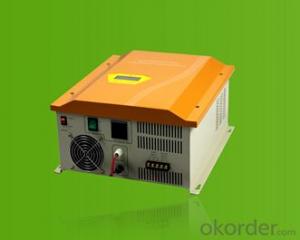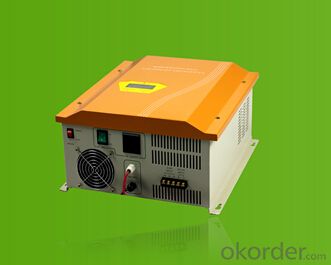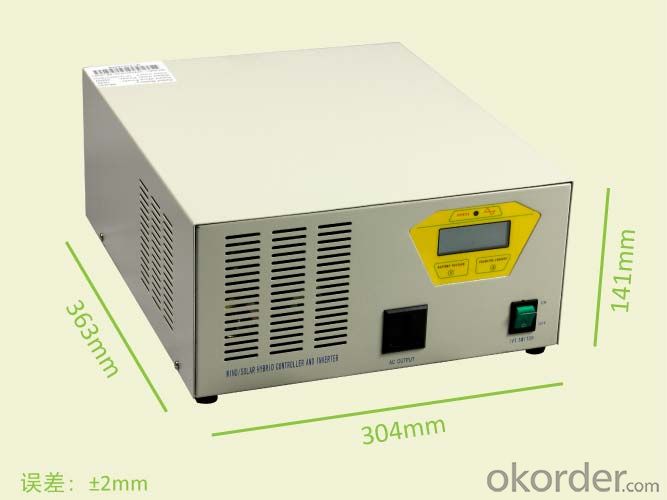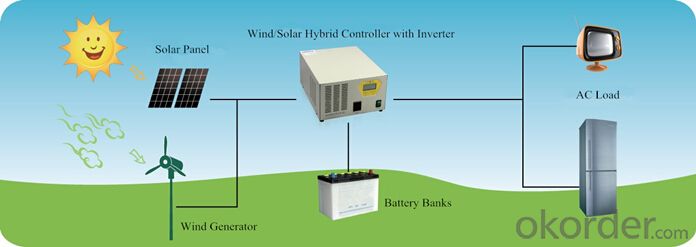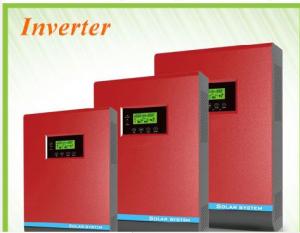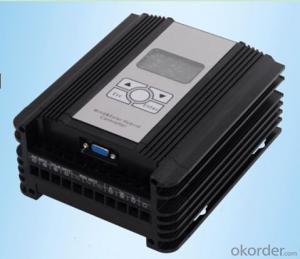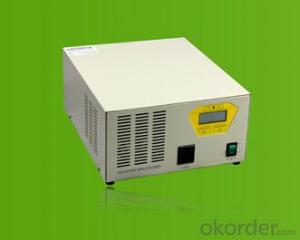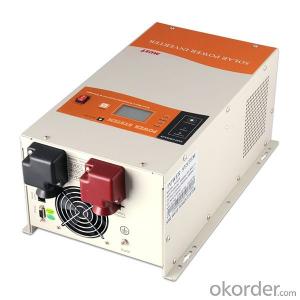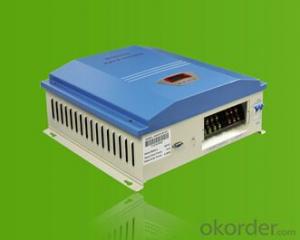Sunways Solar Inverter 1kw Wind Solar Hybrid Controller with Inverter
- Loading Port:
- Shanghai
- Payment Terms:
- TT or LC
- Min Order Qty:
- 1 unit
- Supply Capability:
- 5000 unit/month
OKorder Service Pledge
OKorder Financial Service
You Might Also Like
I. PRODUCT INTRODUCTION
Wind/solar hybrid controller with inverter is the intelligent power supply with integration of wind/solar control and DC to AC inverse.
The apparatus is mainly used for wind /solar renewable energy power system; provide effective power supply for traffic inconvenience, harsh environment of mountain area, a pasturing area, border, islands and other areas without electricity.
With decent appearance, easy operation, and visual indication of LCD, the controller has perfect protection function, high charging efficiency and low no-load loss.
II. PERFORMANCE FEATURES
Perfect protection function, thus the system has higher reliability.
LCD display function, visually display battery voltage and charge current.
Integrated design of controller and inverter, with simple and easy maintenance.
PWM stepless unload mode, which burn excess power into dump load, making the battery charging in the best status.
Power frequency toroidal transformer, ensures inverter has high efficiency and low no-load loss.
Pure sine wave output, compared with square wave or modified wave, has higher efficiency and higher capability of driving load.
Certificate for Invention Patent of wind/solar hybrid controller with inverter, European CE.
III. APPLICATION AREAS
Domestic household wind power and photovoltaic power system, wind power station and photovoltaic power station.
Coastal islands, remote mountainous, border posts for regions shortage of or without electricity.
Government demonstration projects, landscape lighting project.
Mobile communication base station, expressway and other non-residential regions.
IV. 600W-1KW TECHNICAL PARAMETERS
Product Mode | WWSI0606-24 | WWSI0610-24 | WWSI1010-48 |
Rated wind turbine power | 600 W | 600 W | 1000 W |
Rated solar panel power | 180 W | 180 W | 300 W |
Floating charging voltage | 29 V | 29 V | 58 V |
Dump load current | 25 A | 25 A | 21 A |
Rated inverter output capacity | 600 VA | 600 VA | 1000 VA |
Rated battery banks voltage | 24 V | 24 V | 48 V |
Over voltage shutoff | 34 V | 34 V | 68 V |
Over voltage recovery | 33 V | 33 V | 66 V |
Battery over-discharge shutoff | 21.6 V | 21.6 V | 43.2 V |
Battery over-discharge recovery | 24 V | 24 V | 48 V |
No-load loss current | ≤0.7 A | ≤0.7 A | ≤0.5 A |
Net weight | 13 kg | 16 kg | 16 kg |
dimension | 400×340×160 mm | ||
Output wave | pure sine wave | ||
Display mode | LCD | ||
Cooling | Fan | ||
Rated output power | 110/120/220/230/240 VAC | ||
Wave distortion | ≤4% | ||
Output frequency | 50/60±0.5 Hz | ||
Dynamic response | 5% | ||
Power factor | ≥0.8 | ||
Over-load capacity | 120% 1min, 150% 10s | ||
Inverter efficiency | 90% Maximum | ||
Isolating mode | frequency toroidal transformer | ||
Protection level | IP20(Indoor) | ||
Noise (1 meter) | ≤40dB | ||
Insulating strength | 1500VAC, 1min | ||
Protection functions | Battery over-charge protection; battery over-discharge protection; battery reverse connection protection; output overload protection; output short circuit protection; overheating protection; solar reverse charge protection; solar reverse connection protection; automatic brake and manual brake protection; lighting protection | ||
Working temperature | -20~+55℃ | ||
Ambient humidity | 0~93%, without condensing | ||
Working altitude | ≤4000m | ||
In order to serve our customers better. Our company can adjust parameters configuration according to customer’s requirement. | |||
V. APPENDIX
Optional Functions | |
Ø By-pass function: It will switch to the city grid automatically when the battery is under voltage, which ensures the continuity and stability of system. | Ø English display |
Friendly reminder: users should offer following information when ordering wind/solar hybrid controller with inverter | |
Ø Rated battery voltage | Ø Rated wind turbine power |
Ø Rated solar panel power | Ø Load peak power and load characteristics |
Ø With or without by-pass function | Ø Inverter output capacity, rated output voltage and rated output frequency |
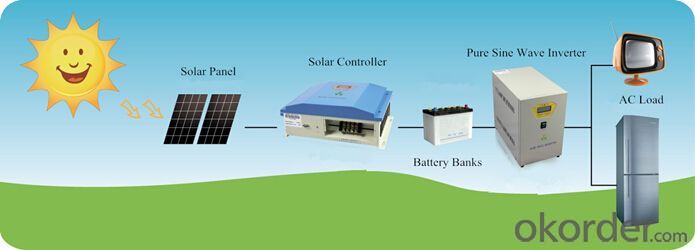
- Q: How does a solar inverter handle harmonics in the grid?
- A solar inverter handles harmonics in the grid by implementing various techniques such as filtering, synchronization, and control algorithms. These techniques help in mitigating harmonics and ensuring that the power generated from the solar panels is synchronized and compatible with the grid's electrical frequency and voltage. The inverter's control system monitors the grid's harmonics and adjusts its output accordingly to minimize any adverse effects and maintain grid stability.
- Q: How does shading impact the performance of a solar inverter?
- Shading can significantly impact the performance of a solar inverter by reducing the overall energy production of the solar panels. When certain parts of the solar panel are shaded, it creates an imbalance in the current flow, resulting in a decrease in the energy output. This can lead to a decline in the overall efficiency and power generation of the solar inverter. To mitigate this issue, technologies like bypass diodes are used in solar panels to minimize the impact of shading and ensure optimal performance.
- Q: Can a solar inverter be used in grid-tied systems?
- Yes, a solar inverter can be used in grid-tied systems. In fact, a grid-tied system requires a solar inverter to convert the DC power generated by the solar panels into AC power that can be fed into the electrical grid. The solar inverter also ensures that the system synchronizes with the grid and complies with safety regulations.
- Q: What is the role of a grid connection feature in a solar inverter?
- The role of a grid connection feature in a solar inverter is to allow the solar power system to connect and interact with the electrical grid. This feature enables the solar inverter to convert the direct current (DC) produced by the solar panels into alternating current (AC) that is compatible with the electrical grid. It ensures that excess solar energy can be fed back into the grid, allowing the system owner to receive credit or payments for the electricity generated. Additionally, the grid connection feature allows the system to draw power from the grid when solar energy is insufficient, ensuring a reliable and continuous power supply.
- Q: Can a solar inverter be used with different types of solar panels?
- Yes, a solar inverter can be used with different types of solar panels as long as the voltage and current specifications of the panels are compatible with the inverter.
- Q: What is the role of a solar inverter in optimizing energy production?
- The role of a solar inverter in optimizing energy production is to convert the direct current (DC) electricity generated by solar panels into alternating current (AC) electricity that can be used to power homes or be fed into the electrical grid. Additionally, solar inverters also help in ensuring that the solar system operates at its maximum efficiency by tracking the maximum power point (MPP) and adjusting the voltage and current accordingly. This optimization helps to maximize the energy production from the solar panels and ensures that the system is operating at its peak performance.
- Q: Can a solar inverter be used in regions with high temperature extremes?
- Yes, solar inverters can be used in regions with high temperature extremes. However, it is important to choose inverters that are specifically designed to handle such conditions, as excessive heat can affect their performance and lifespan. These inverters should have features like advanced thermal management systems, wide temperature operating ranges, and robust cooling mechanisms to ensure optimal functioning and durability even in extreme temperatures.
- Q: How does a solar inverter handle electromagnetic interference?
- A solar inverter handles electromagnetic interference (EMI) by incorporating various measures to reduce and mitigate its impact. These measures include using shielding materials, implementing proper grounding techniques, and utilizing filters to suppress EMI. Additionally, advanced inverters may employ digital signal processing techniques to minimize the effects of EMI on the solar power system.
- Q: Can a solar inverter be used in systems with different module currents?
- Yes, a solar inverter can be used in systems with different module currents. Solar inverters are designed to convert the DC power generated by solar panels (modules) into AC power that can be used by electrical devices. They are typically equipped with Maximum Power Point Tracking (MPPT) technology, which allows them to optimize the power output from the solar panels regardless of their current ratings. This means that solar inverters can efficiently handle systems with different module currents and ensure the maximum power generation from the solar panels.
- Q: Can a solar inverter be used with a three-phase electrical system?
- Yes, a solar inverter can be used with a three-phase electrical system. In fact, many commercial and industrial solar installations use three-phase inverters to convert the direct current (DC) power generated by solar panels into alternating current (AC) power that can be used by the electrical grid. This allows for efficient power conversion and distribution in three-phase systems, which are commonly used in larger electrical installations.
Send your message to us
Sunways Solar Inverter 1kw Wind Solar Hybrid Controller with Inverter
- Loading Port:
- Shanghai
- Payment Terms:
- TT or LC
- Min Order Qty:
- 1 unit
- Supply Capability:
- 5000 unit/month
OKorder Service Pledge
OKorder Financial Service
Similar products
Hot products
Hot Searches
Related keywords
